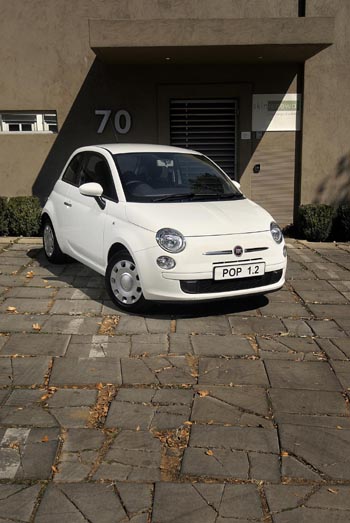 |
|
Roberto Giolito,
the Head of Fiat Centro Stile,
receives the 'Award of the Awards' from the
President of the Italian Republic, Giorgio
Napolitano. |
|
 |
|
|
|
 |
|
Demonstration the success of the Fiat 500
are the 300,000 customers who have purchased
it all over the globe in just under two
years since it was launched on the market,
much more than the initial forecasts. |
|
|
|
On
the occasion of National Innovation Day, which
was held in Rome at the Quirinal building in the
presence of the Head of State, the Prize of
prizes was awarded to the Fiat 500. This award
is given by the Ministry for Public
Administration and Innovation, which aims at
supporting entrepreneurial skills, the
university world, public administration and the
tertiary sector, as well as to provide
incentives to pursue creative activities in
order to develop a culture of change. Innovation
means the transformation of an idea into a
sellable product or operational process (either
new or improved) in commerce, industry or even
in the new approach of a social service.
The award was
also devised to highlight the importance the Italian
Government places on companies, public and private bodies
and individual inventors, supporting their role in the
social, economic and scientific development of the Country,
facilitating osmosis between an entrepreneurial and
financial world and the business culture. The Prize of
prizes was collected by Lorenzo Ramaciotti (head of Style
at Fiat Group Automobiles and Maserati) and Roberto Giolito,
head of the Fiat Centro Stile and designer of the 500.
The natural way
in which the design of the 500 was dealt with at the Fiat
Style Centre made it possible to assimilate to perfection
great technical expertise with the ability to express the
strength of the brand. The new 500 is first and foremost a
car that is usable by everyone and today the concept of
usability is among the most modern in design. The result is
a car capable of stirring your emotions and offering all the
latest technical features. That is exactly why the
appearance of the previous 500 was reinterpreted for the
modern customer, taking into account three fundamental
aspects in particular. First of all the style, recognisable
and always trendy thanks to a design that makes a statement
of its identity; its being "easy", designed for an intuitive
and instinctive approach, without secrets yet with great
abilities; and lastly the added value of it being
"personal", i.e. devised and customised for the customer,
brimming with solutions which make it so appealing. The
manufacturer didn't strive to make a car that looked like
the 500, but rather a car that was the 500 "anew", following
in the footsteps of the great small city cars from Turin
which commenced with the 1930s Topolino.
Demonstration of
the success of this approach are the 300,000 customers who
have purchased it all over the globe in just under two years
since it was launched on the market, much more than the
initial forecasts. What's more, all sorts of customers go
for the Fiat 500. The most popular version is the richer
“Lounge” with a 1.2 69 HP petrol engine and the favourite
colour is Bossa Nova White.
The 500 also
boasts some other records: it is the first car in segment A
with the highest safety level (5 stars of the EuroNCAP
regulation) and with the lowest pollution rate of its
category, with engines that since its debut on the market
complied with the Euro 5 directive. Its technical features,
which are uncommon for such a small car – including the 7
air-bags which guarantee total protection for driver and
passengers, the last generation petrol and diesel engines,
the high efficiency body in terms of rigidity and resistance
which have already been rewarded in the specific technical
spheres – make the 500 an excellent example of what is today
defined as “downsizing”, i.e. conveying to the small vehicle
all the benefits which were an exclusive of the superior
segments and categories, while maintaining low emissions and
respecting the environment and the collective space.
The challenge of
the 500 in all its versions (including the 500C to be
launched in a few weeks' time) is not to perform an exercise
of futuristic and hyper-technological representation, but to
offer a concrete and real mobility solution as the new Fiat
city-car, with profound roots in the brand's history.
|